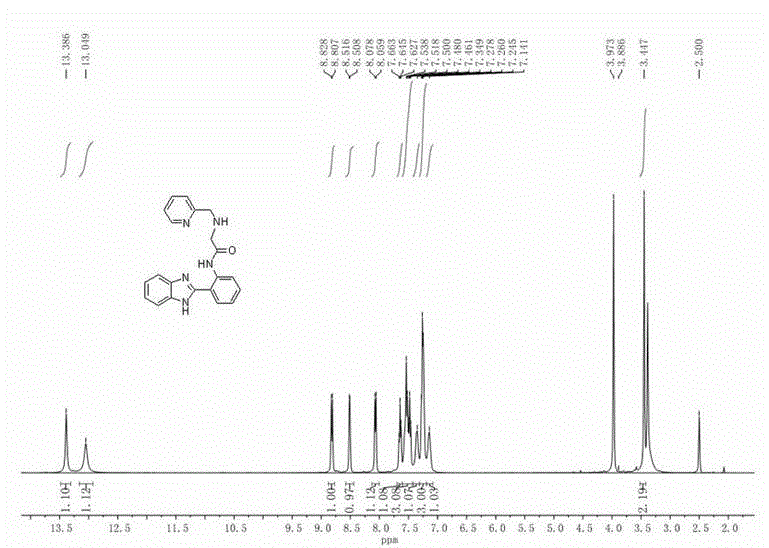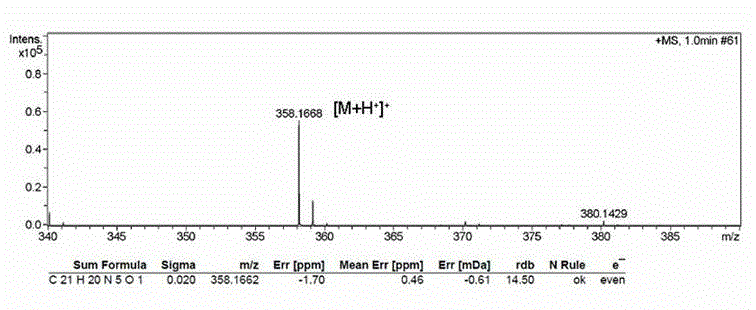Excited state intramolecular proton transfer regulation based fluorescence probe, and synthetic method and applications thereof
A fluorescent probe and proton transfer technology, applied in the field of fluorescent probes and their synthesis, can solve the problems of fluorescence enhancement and quenching, and achieve the effect of simple raw materials, avoiding the influence of external factors, and simple separation and purification process of products
- Summary
- Abstract
- Description
- Claims
- Application Information
AI Technical Summary
Problems solved by technology
Method used
Image
Examples
Embodiment 1
[0041] (1) Synthetic relay recognition Zn 2+ and S 2- The reaction formula of the ratiometric fluorescent probe:
[0042]
[0043] (2) Synthetic relay recognition of Zn 2+ and S 2- The specific steps of the ratiometric fluorescent probe:
[0044] Weigh 300mg of the intermediate N -(2-(1 H-Benzimidazolyl)phenyl)-2-chloroacetamide (compound 1) and 170mg 2-aminomethylpyridine, dissolved in 10ml N,N - In dimethylformamide (DMF), stir the reaction at room temperature for 5 hours, add 200ml of distilled water to dilute, adjust the pH value to 7.5 with dilute hydrochloric acid, collect the resulting precipitate by filtration, and recrystallize with acetonitrile to obtain a fluorescent probe N -(2-(1H-Benzimidazolyl)phenyl)-2-(2-aminomethylpyridyl)acetamide (compound L), yield 65%.
Embodiment 2
[0046] Weigh 400mg of the intermediate N -(2-(1H-Benzimidazolyl)phenyl)-2-chloroacetamide (compound 1) and 300mg 2-aminomethylpyridine, dissolved in 13ml N,N - In dimethylformamide (DMF), stir the reaction at room temperature for 8 hours, add 200ml of distilled water to dilute, adjust the pH value to 7 with dilute hydrochloric acid, collect the resulting precipitate by filtration, and recrystallize with acetonitrile to obtain a fluorescent probe N -(2-(1H-Benzimidazolyl)phenyl)-2-(2-aminomethylpyridyl)acetamide, the yield was 71%.
Embodiment 3
[0048] Weigh 500mg of the intermediate N -(2-(1H-Benzimidazolyl)phenyl)-2-chloroacetamide (compound 1) and 560mg of 2-aminomethylpyridine, dissolved in 15ml of DMF, stirred at room temperature for 10h, Add 250ml of distilled water for dilution, adjust the pH value to 6.5 with dilute hydrochloric acid, collect the resulting precipitate by filtration, and recrystallize with acetonitrile to obtain a fluorescent probe N -(2-(1H-Benzimidazolyl)phenyl)-2-(2-aminomethylpyridyl)acetamide, the yield was 76%.
[0049] The fluorescent probe of embodiment 1~embodiment 3 N -(2-(1 H Basic data for -benzoimidazolyl)phenyl)-2-(2-aminomethylpyridyl)acetamide:
[0050] Melting point: 179℃~180℃;
[0051] 1 H NMR (400 MHz, DMSO- d 6 ) δ 13.39 (s, 1H), 13.05 (s, 1H), 8.81 (d, J = 8.3 Hz, 1H), 8.51 (d, J = 3.3 Hz, 1H), 8.06 (d, J = 7.7 Hz, 1H), 7.63 (t, J = 7.3 Hz, 1H), 7.54-7.46 (m, 3H), 7.35 (s, 1H), 7.35 –7.25 (m, 3H), 7.14 (s, 1H), 3.97 (s, 2H), 3.45 (s, 2H). (eg figure 1 )....
PUM
| Property | Measurement | Unit |
|---|---|---|
| Melting point | aaaaa | aaaaa |
Abstract
Description
Claims
Application Information
 Login to View More
Login to View More - R&D
- Intellectual Property
- Life Sciences
- Materials
- Tech Scout
- Unparalleled Data Quality
- Higher Quality Content
- 60% Fewer Hallucinations
Browse by: Latest US Patents, China's latest patents, Technical Efficacy Thesaurus, Application Domain, Technology Topic, Popular Technical Reports.
© 2025 PatSnap. All rights reserved.Legal|Privacy policy|Modern Slavery Act Transparency Statement|Sitemap|About US| Contact US: help@patsnap.com



